November 27, 2025
How Brands Use Virtual Influencers: Complete Guide to AI-Powered Marketing in 2025
Discover how brands use virtual influencers for marketing campaigns in 2025. Learn benefits, real examples, risks, and strategic approaches to AI influencer partnerships for US brands.
Virtual influencers are computer-generated characters that post content on social media. Real brands pay them just like human influencers. In 2024, most people in the US followed at least one virtual influencer.
The market hit $6 billion and will reach $45 billion by 2030. Major fashion brands, tech companies, and ecommerce stores now use these digital characters in campaigns.
Why? You get full control over messaging. No scandals. No scheduling conflicts. Your virtual influencer shows up exactly when and where you need them. This guide shows you how brands actually use virtual influencers and what works.
Key Takeaways

- What They Are: Virtual influencers are AI-powered digital personas that post content and engage audiences on social media platforms
- Why Brands Use Them: You get complete creative control over messaging with no risk of scandals or unpredictable behavior
- Real Applications: Fashion brands, ecommerce stores, and tech companies use them for product demos, campaigns, and personalized content
- Key Advantages: Virtual influencers stay consistent across all channels and can appear in multiple locations at once
- Critical Risks: 46% of US consumers feel uncomfortable with AI influencers and poor execution damages your brand reputation
- Success Factors: Custom virtual influencers paired with quality production deliver better results than generic approaches
Understanding Virtual Influencers
Virtual influencers are computer-generated characters that look and act like real people on social media. They post content, work with brands, and build follower communities just like human influencers do.
What Are Virtual Influencers?
You are looking at digital personas made with computer graphics and AI technology. They post on Instagram, TikTok, and other platforms. They engage with followers and appear in brand campaigns.
The technology includes:

- 3D modeling that creates their face and body
- AI systems that keep their personality consistent
- Motion capture that makes movements look natural
Human avatars take 68% of the market. People connect better with realistic-looking characters. The tech keeps getting better. Soon you will not be able to tell virtual from real.
Notable Examples in the Market
Lil Miquela has 2.6 million Instagram followers. She worked with 91 brands last year and reached 9.9 million people. Calvin Klein, Prada, and Samsung paid her for campaigns. Lu of Magalu started in 2009. She partners with Microsoft and Intel in Brazil. Shudu Gram is the first digital supermodel. Balmain used her in fashion campaigns. These virtual characters prove you can build real audiences with digital people.
How They Differ from Human Influencers
Virtual influencers give you control human creators cannot:

- No scandals because they only say what you write
- Always available with no travel or scheduling problems
- Never age or change unless you want them to
- Cost less over time with no ongoing talent fees
Human influencers bring real experiences and emotions. Virtual ones bring consistency and predictability. You write every post. You control every word. No surprises. No PR disasters. Your message stays exactly on brand.
US Market Adoption
58% of Americans follow at least one virtual influencer. But 46% feel uncomfortable when brands use them. Only 23% are fine with it. This split matters for your strategy. Gen Z accepts them more than older groups. Your target audience decides if virtual influencers will work for your brand.
Why Virtual Influencers Are Revolutionizing Marketing
Brands are moving budget to virtual influencers because they solve problems human creators cannot fix. You get creative freedom, better crisis control, and engagement that drives real sales.
Enhanced Creative Storytelling
Virtual influencers break the rules of physics and location. You can place them underwater, in space, or on a mountaintop. All in the same day. No travel costs. No permits. No weather delays.
Your creative team can:

- Build impossible scenarios that grab attention in crowded feeds
- Test bold concepts without worrying about influencer comfort or safety
- Execute fantasy narratives that traditional shoots cannot deliver
This freedom lets you tell bigger stories. You push creative boundaries without the limits of the physical world. Your campaigns stand out because you can do what others cannot.
Increasing Engagement and Awareness
The data shows virtual influencers work. 36% follow them for entertainment and storytelling. 30% follow for their unique personalities. One in three Gen Z consumers bought something because a virtual influencer recommended it. Your virtual character can drive real purchases when done right.
Improved Crisis Management
Virtual influencers never create PR disasters. They do not have personal opinions that clash with your brand. They do not post controversial statements at 2am. You control every word they say.
Benefits include:
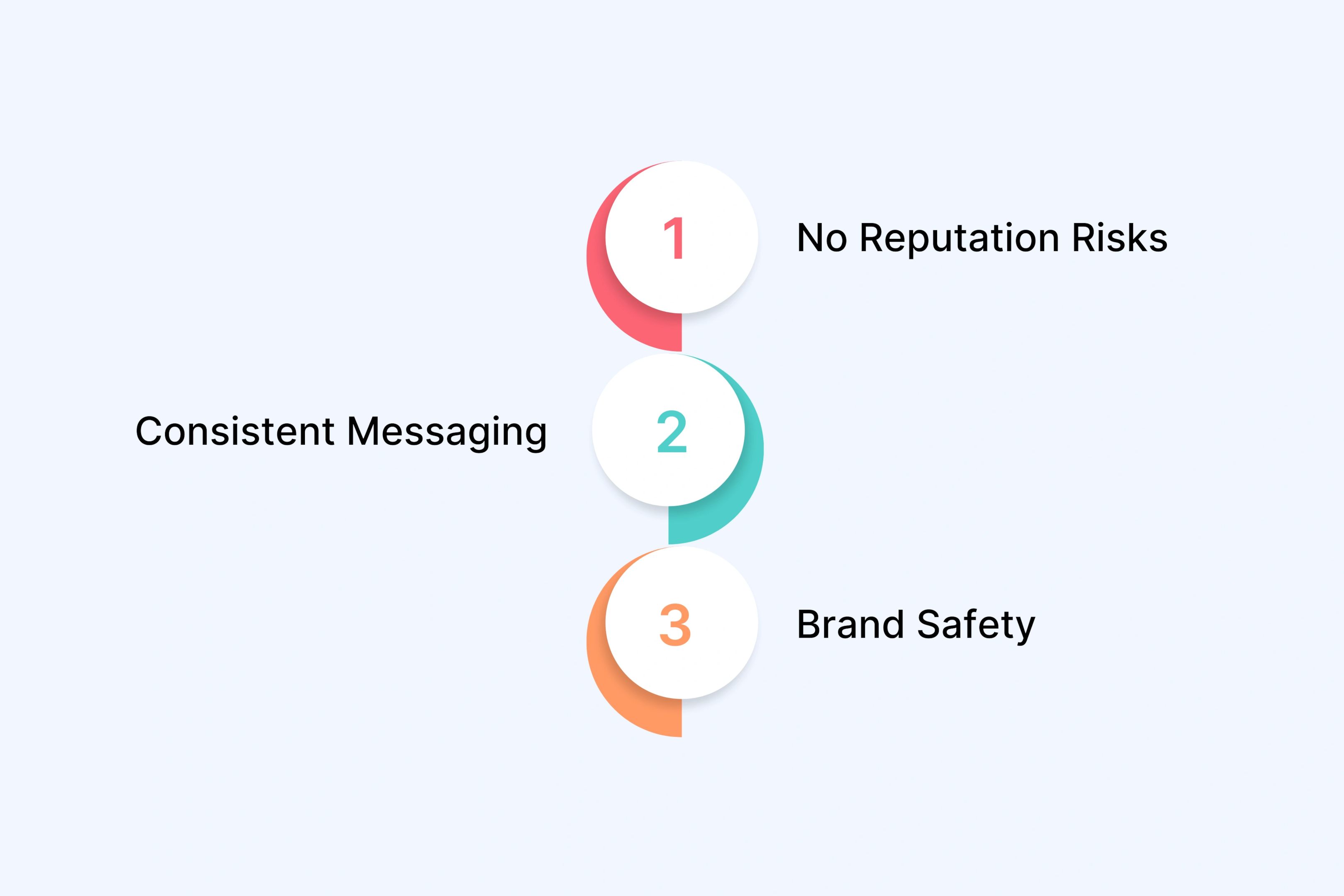
- No reputation risks from influencer behavior
- Consistent messaging during sensitive times
- Brand safety that protects your investment
When human spokespeople face scrutiny, your virtual influencer keeps working. You maintain your message without worrying about what they might say next. This predictability matters when brand reputation is on the line.
Always Available and Scalable
Your virtual influencer works 24/7. No time zones. No sick days. No contract negotiations. You can run campaigns in New York, Tokyo, and Paris at the same time. Same character. Different content. All coordinated perfectly.
Advantages of Virtual Influencers
Virtual influencers give you benefits that human creators cannot match. You control everything. Costs drop over time. Your message stays consistent across every platform and campaign.

No Scandals or Unpredictability
Virtual influencers have zero risk of online scandals. They do not have personal lives. They do not post opinions that clash with your brand values. Every word is scripted. Every action is approved.
You get:
- Total control over what they say and do
- No PR disasters from unexpected behavior
- Perfect alignment with your brand message every time
Human influencers can damage your reputation overnight. Virtual ones protect it. You write the script. They follow it exactly.
Cost Effectiveness for Long-Term Partnerships
Virtual influencers cost more upfront but save money over time. Lil Miquela charges $9,000 per post. Human influencers with similar reach charge $250,000. Once you create a virtual character, you reuse them forever.
No costs for:
- Travel or accommodations for shoots
- Talent fees for each new campaign
- Styling or makeup for appearances
Your virtual influencer is a one-time investment. Every campaign after the first one costs less. Over months and years, the savings add up fast.
Ability to Appear in Multiple Locations at Once
Your virtual influencer can be in five cities at the same time. Post from New York at 9am. Tokyo at noon. London at 3pm. All the same day. All with fresh content made for each audience.
This matters when:
- Running global campaigns across time zones
- Testing different messages in different markets
- Scaling content production without hiring more people
Geography stops being a problem. Your virtual character goes anywhere instantly.
Adaptability
Virtual influencers change fast. New trend on TikTok? Your character joins it today. Need a different look for summer? Update their appearance overnight. Want to test five different messages? Create five versions of the same post.
You can:
- Pivot to trends faster than human creators
- Update appearance to match seasonal campaigns
- Tailor content to specific audience segments
Human influencers need time to adjust. Virtual ones adapt instantly.
Consistency
Virtual influencers never change unless you want them to. Same face. Same voice. Same personality. Year after year. Human influencers age, change styles, and evolve their personal brands. Sometimes away from your brand values.
Your virtual character stays:
- Visually consistent across all content
- On message for every campaign
- Aligned with your brand no matter what
This consistency builds recognition. Your audience knows what to expect. Your brand message never drifts.
Benefits of Virtual Influencers for Social Media Marketing
Virtual influencers fit perfectly into social media strategies. You post across platforms, reach specific audiences, and scale content fast without the limits of human creators.
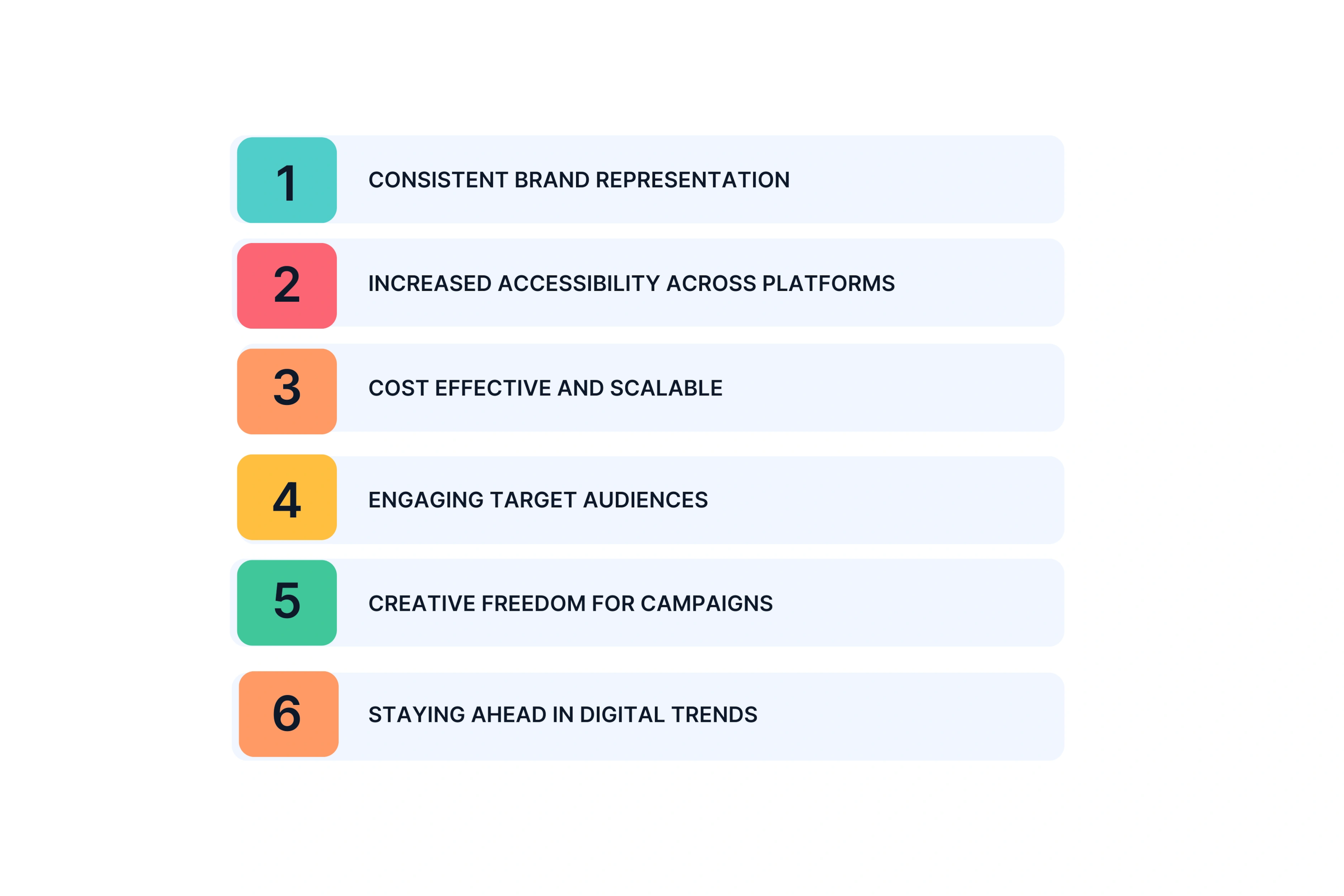
Consistent Brand Representation
Your virtual influencer never goes off brand. Every post matches your voice. Every message supports your goals. You control the tone, style, and content across Instagram, TikTok, YouTube, and every other platform.
This gives you:
- Uniform messaging that never varies from your strategy
- No surprise posts that contradict your brand values
- Perfect alignment between what they say and what you want
Human influencers have their own voice. Sometimes it clashes with yours. Virtual ones speak exactly how you tell them.
Increased Accessibility Across Platforms
Your virtual character can post on five platforms at once. Different content for each. All optimized for how audiences use that platform. Instagram gets lifestyle shots. TikTok gets short videos. YouTube gets longer stories.
You reach:
- Different audiences where they spend time
- Multiple demographics with tailored content
- Global markets without coordination headaches
Human influencers pick their favorite platforms. Virtual ones work everywhere you need them.
Cost Effective and Scalable
After you create your virtual influencer, making content costs less than working with human creators. You produce 10 videos, 50 videos, or 100 videos without proportional cost increases. The more you make, the cheaper each piece gets.
Benefits include:
- Lower production costs per piece of content
- No talent fees for each new campaign
- Faster turnaround without scheduling conflicts
You scale up without breaking your budget. Make more content. Test more ideas. All at a fraction of traditional costs.
Engaging Target Audiences
One in three Gen Z consumers bought something because a virtual influencer recommended it. 36% follow virtual influencers for entertainment and storytelling. These digital characters capture attention in ways human creators cannot.
You create virtual influencers that:
- Match your target demographic exactly
- Speak to specific audience interests precisely
- Generate curiosity that drives engagement
Design matters. Your virtual character should reflect who you want to reach. Age, style, personality all match your ideal customer.
Creative Freedom for Campaigns
Virtual influencers let you execute any concept. Impossible locations. Fantasy scenarios. Rapid changes. You test ideas human creators cannot do. Your only limit is imagination and production capability.
This freedom helps you:
- Stand out in crowded social feeds
- Test bold concepts without risk
- Iterate quickly based on what works
Creative boundaries disappear. You build campaigns that grab attention because you do what others cannot.
Staying Ahead in Digital Trends
Using virtual influencers shows your brand understands where marketing is going. You position yourself as forward thinking. Tech-savvy audiences notice when brands adopt new approaches early.
You gain:
- Competitive advantage while others hesitate
- Innovation credibility with younger audiences
- First-mover benefits in your industry
Early adopters build expertise and audience relationships now. Latecomers play catch up in crowded spaces later. Your timing matters for long-term success.
How Do Virtual Influencers Offer Complete Creative Control?
Virtual influencers give you control that human creators cannot match. You decide every word, every action, every detail. Nothing happens without your approval.

Total Content Control
You write the script. Your virtual influencer follows it exactly. Every post aligns with your brand guidelines. Every message supports your campaign goals. No improvisation. No personal opinions slipping in.
You control:
- Every word they say in posts and comments
- Every visual from clothing to background
- Every timing decision for maximum impact
Human influencers bring their own creative ideas. Sometimes those ideas work. Sometimes they clash with your vision. Virtual influencers execute your vision perfectly every time.
Elimination of Human Unpredictability
Real people have bad days. They post things they regret. They say controversial things. They change their minds about your brand. Virtual influencers skip all that drama.
No risk of:
- Off-brand statements that damage your reputation
- Personal controversies that spill onto your campaign
- Mood changes that affect content quality
You mentioned scandals earlier. This is how you avoid them. Your virtual influencer has no personal life to complicate things. No opinions that might alienate customers. No surprises at all.
Precise Brand Alignment
Your virtual influencer embodies your brand values exactly. You design their personality to match what you want to communicate. Their style reflects your aesthetic. Their voice uses your tone.
This precision means:
- Perfect messaging that never drifts from strategy
- Consistent personality across all platforms
- Exact targeting of your ideal customer profile
Human influencers have authentic personal brands. Those brands might evolve away from yours over time. Virtual ones stay locked to your vision permanently.
Testing and Iteration Freedom
You can test five different versions of the same content. Different outfits. Different messages. Different backgrounds. All with the same virtual influencer. All in the same day.
Testing capabilities include:
- Multiple content variations for A/B testing
- Rapid changes based on performance data
- Zero coordination headaches with talent
Human influencers need time and negotiation for changes. Virtual ones adapt instantly. You see what works. You double down fast.
Campaign Precision
Every detail of your campaign executes exactly as planned. Product placement happens where you want it. Brand mentions use your exact phrasing. Call-to-action language matches your conversion strategy.
You optimize:
- Product visibility in every frame
- Message hierarchy in every post
- Conversion elements for maximum impact
This precision turns creative control into business results. Nothing is left to chance. Everything serves your goals.
The Production Reality: Why Brands Choose Creative Partners
Creating a virtual influencer is only 20% of the work. The real challenge is making quality content that keeps your social media presence strong and drives audience engagement.
The Hidden Complexity of Virtual Influencer Content
You need more than just a digital avatar. Every post needs scripts that sound natural. Every video needs scenarios that feel real. Every campaign needs brand integration that does not look forced.
Production requirements include:
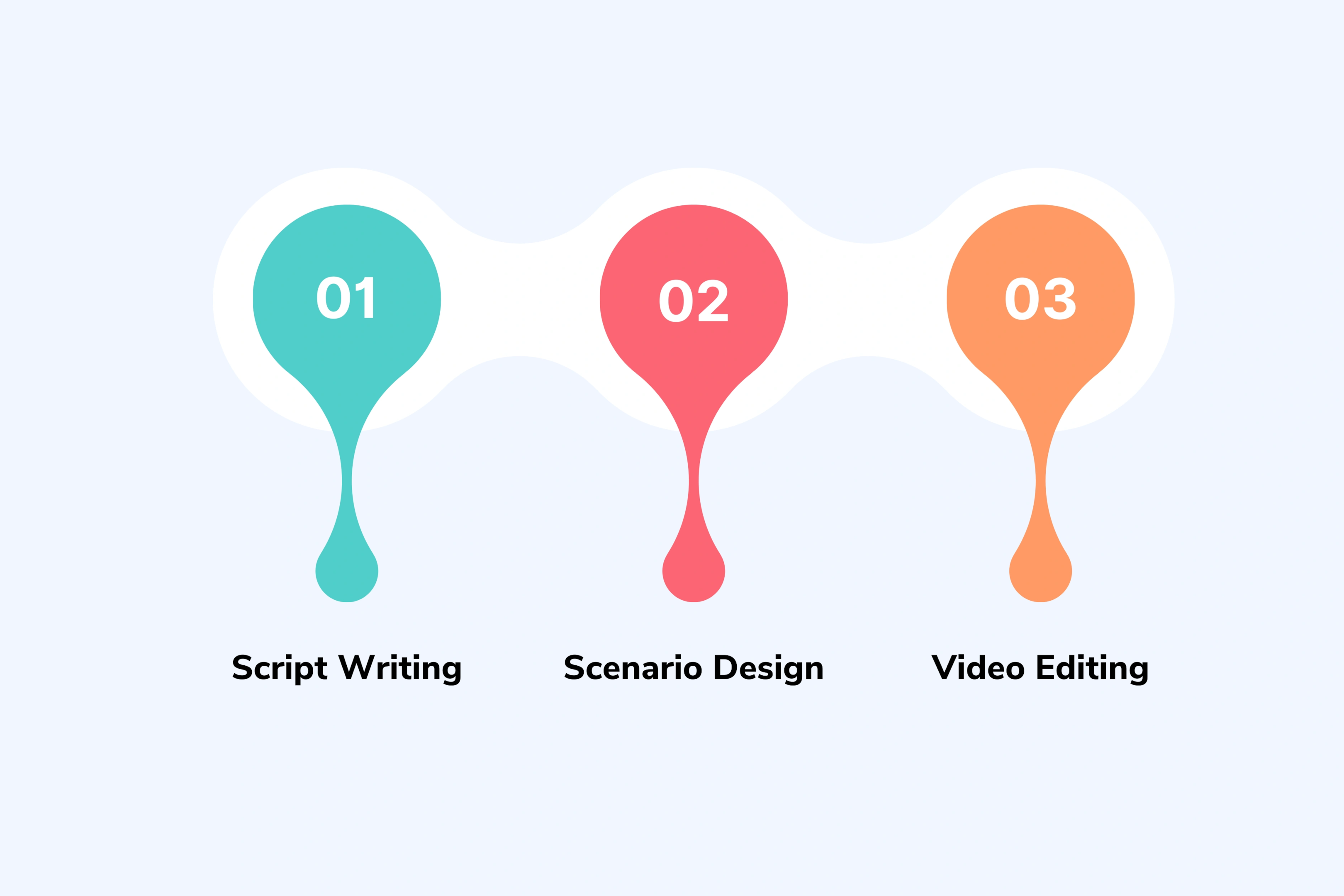
- Script writing that matches your virtual influencers personalities
- Scenario design for immersive storytelling that connects
- Video editing that makes computer graphics look lifelike
Unlike human influencers who bring their own creative approach, AI powered personas need you to build everything. Most brands discover this complexity too late.
The Agency vs Partner vs Tool Problem
You have three options. Each has big tradeoffs.
- Traditional agencies charge high fees and take weeks. Your campaign moves slow. Costs pile up. Unlike traditional influencers who can start posting tomorrow, agency timelines kill momentum.
- Self-service tools sound cheap but eat your time. Your team learns software. Quality varies wildly. You spend months getting results that still look amateur compared to real life influencers.
- Creative partners handle end-to-end production. You get expert execution without building internal teams. Unlike the mentioned earlier options, partners deliver finished videos in days not weeks.
What End-to-End Production Actually Means
You start with a brief. Your creative partner delivers finished videos ready to post. Everything in between gets handled for you.
Complete production includes:
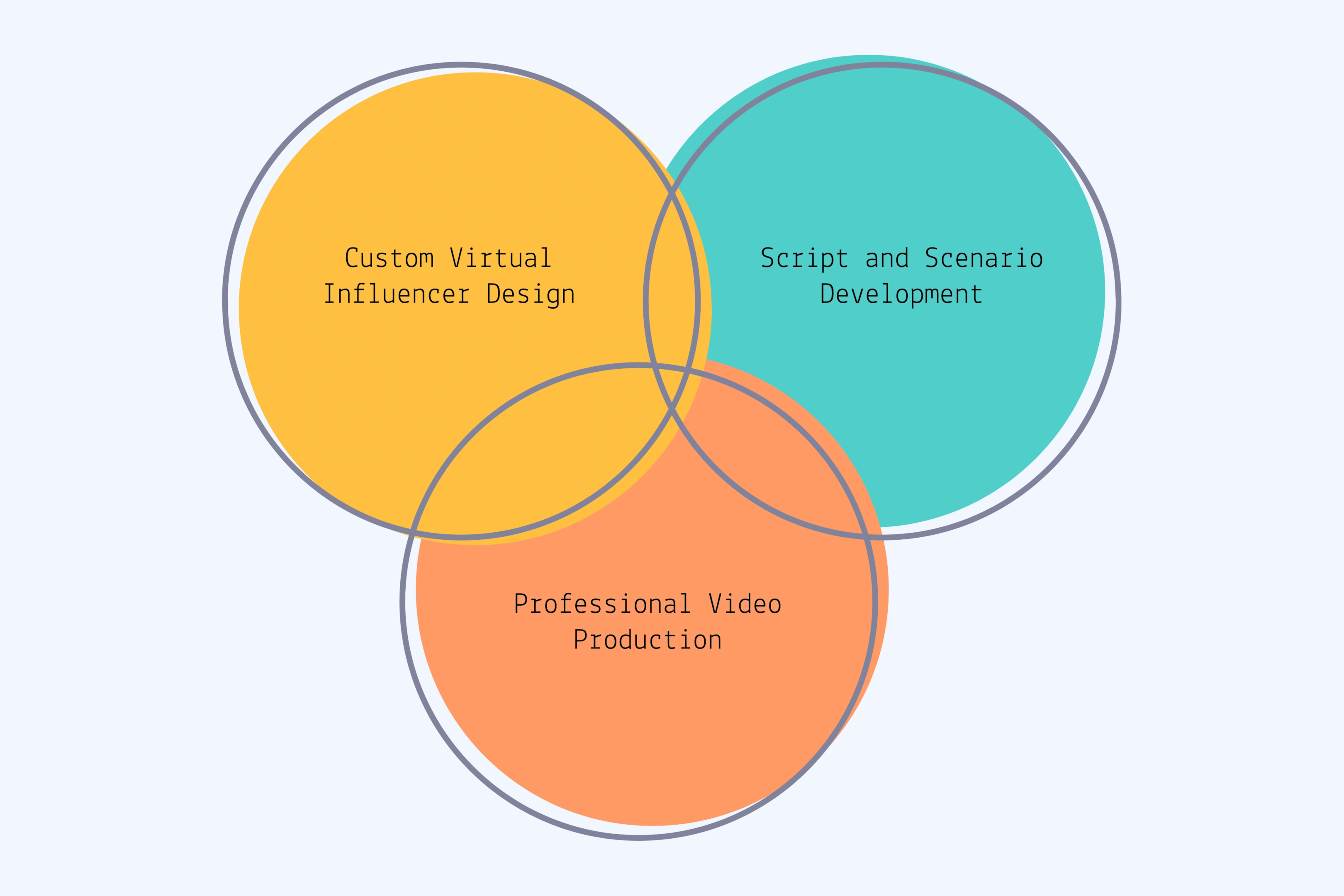
- Custom virtual influencer design matching your target audience
- Script and scenario development for each campaign
- Professional video production from concept to final edit
This matters because AI influencers need consistent quality to work. One bad video damages trust. Your audience sees through cheap execution fast.
The Scale Advantage
Brand partnerships work when you produce volume. Ten videos. Fifty videos. One hundred videos. All maintaining quality. All keeping your influencer's persona consistent.
Creative partners give you:

- Consistent output across large campaigns
- Lower per-video costs as volume grows
- Fast iteration when you spot the latest trends
You cannot build this capability in-house without major investment. Human counterparts cost too much at scale. Virtual influencers only make financial sense when you produce enough content to justify the setup.
Quality production separates brands that succeed with digital avatars from brands that waste budget on experiments that flop.
Real-World Examples: How Leading Brands Partner with Virtual Influencers
Major brands across fashion, tech, and retail use virtual influencers to reach new audiences and test bold creative concepts. Here are real campaigns with real results.
Fashion Industry Success Stories
Balmain launched a campaign with three digital women including Shudu Gram. The campaign generated millions of impressions and positioned Balmain as forward thinking. Lil Miquela took over Prada's Instagram during Milan Fashion Week. She posted behind-the-scenes content and product shots that drove engagement from younger followers.
Calvin Klein paired Lil Miquela with Bella Hadid in a controversial campaign. The virtual and human pairing sparked massive conversation. Millions shared and debated the content. Unlike human influencers who might shy away from controversy, the virtual character executed the bold concept perfectly.
Key fashion wins include:
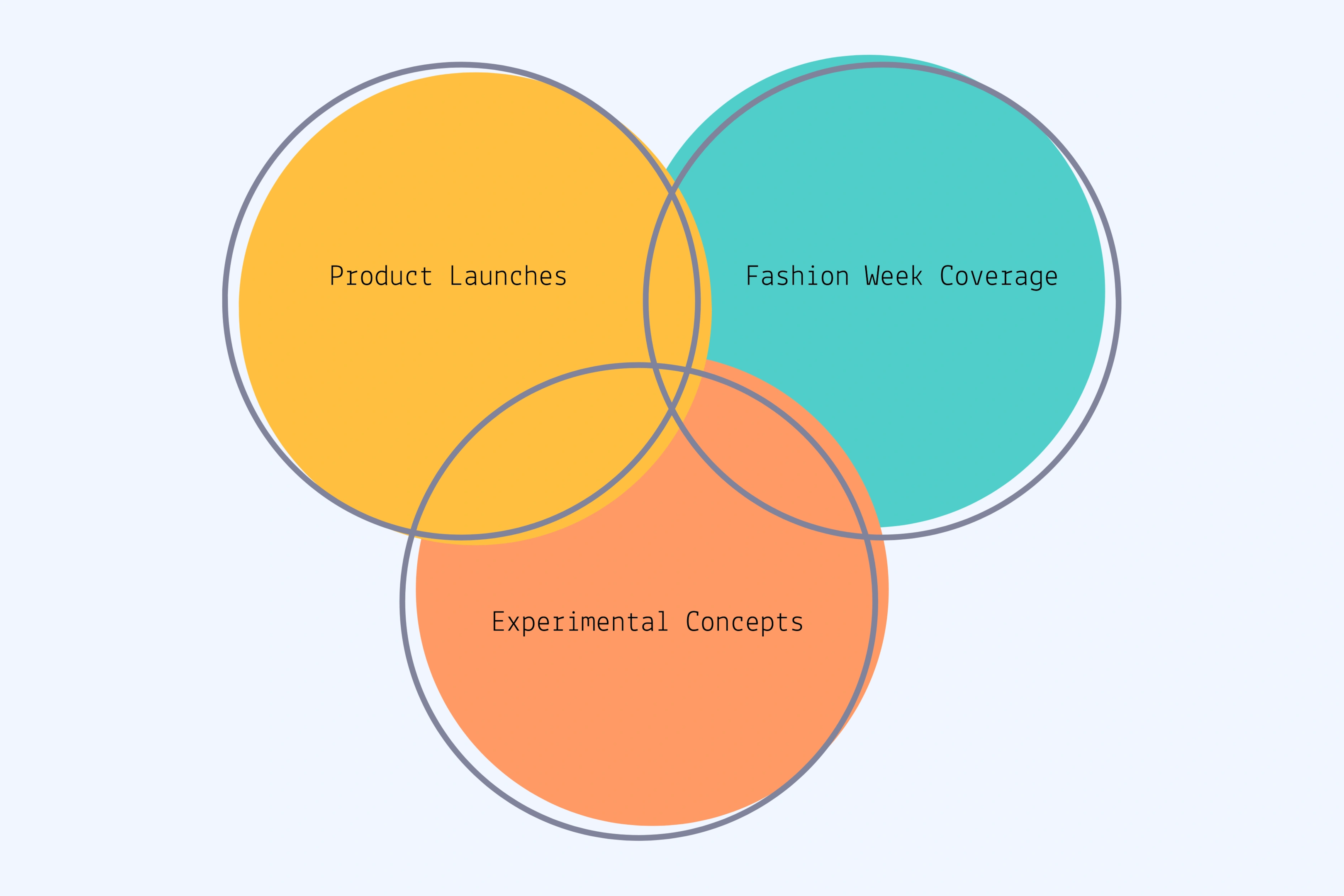
- Product launches with controlled messaging
- Fashion week coverage without travel logistics
- Experimental concepts that human models might refuse
These luxury brands proved virtual influencers work for high-end positioning when execution quality matches brand standards.
Technology Brands Targeting US Markets
Samsung featured Lil Miquela in their TeamGalaxy campaign. She embodied their "Do What You Can't" message. The campaign reached millions of US Gen Z consumers. Unlike traditional influencers who need convincing about tech features, the AI influencers delivered product messaging exactly as Samsung wanted.
Tech brands benefit because:

- Product demonstrations stay perfectly on script
- Innovation messaging aligns with virtual character novelty
- Feature highlights get communicated without confusion
The virtual format reinforces that these brands live at the technology edge. Your audience sees both the product and the delivery method as innovative.
Beauty and Lifestyle Applications
Beauty brands use virtual influencers for makeup tutorials and product showcases. The digital format lets them show products on consistent skin tones. They test different looks rapidly. They create aspirational content without physical production limits.
Sponsored posts from virtual beauty influencers perform well because you can:

- Control lighting and presentation perfectly
- Show products from ideal angles every time
- Create tutorials that never have errors
Unlike human influencers whose appearance changes daily, virtual ones maintain consistency that makes before-and-after comparisons clear.
E-commerce and D2C Success
Direct-to-consumer brands use virtual influencers for product demos, testimonials, and lifestyle video content. One sustainable fashion brand used a virtual influencer to discuss climate change and ethical production. The messaging stayed perfectly aligned with brand values because every word was approved.
E-commerce wins include:
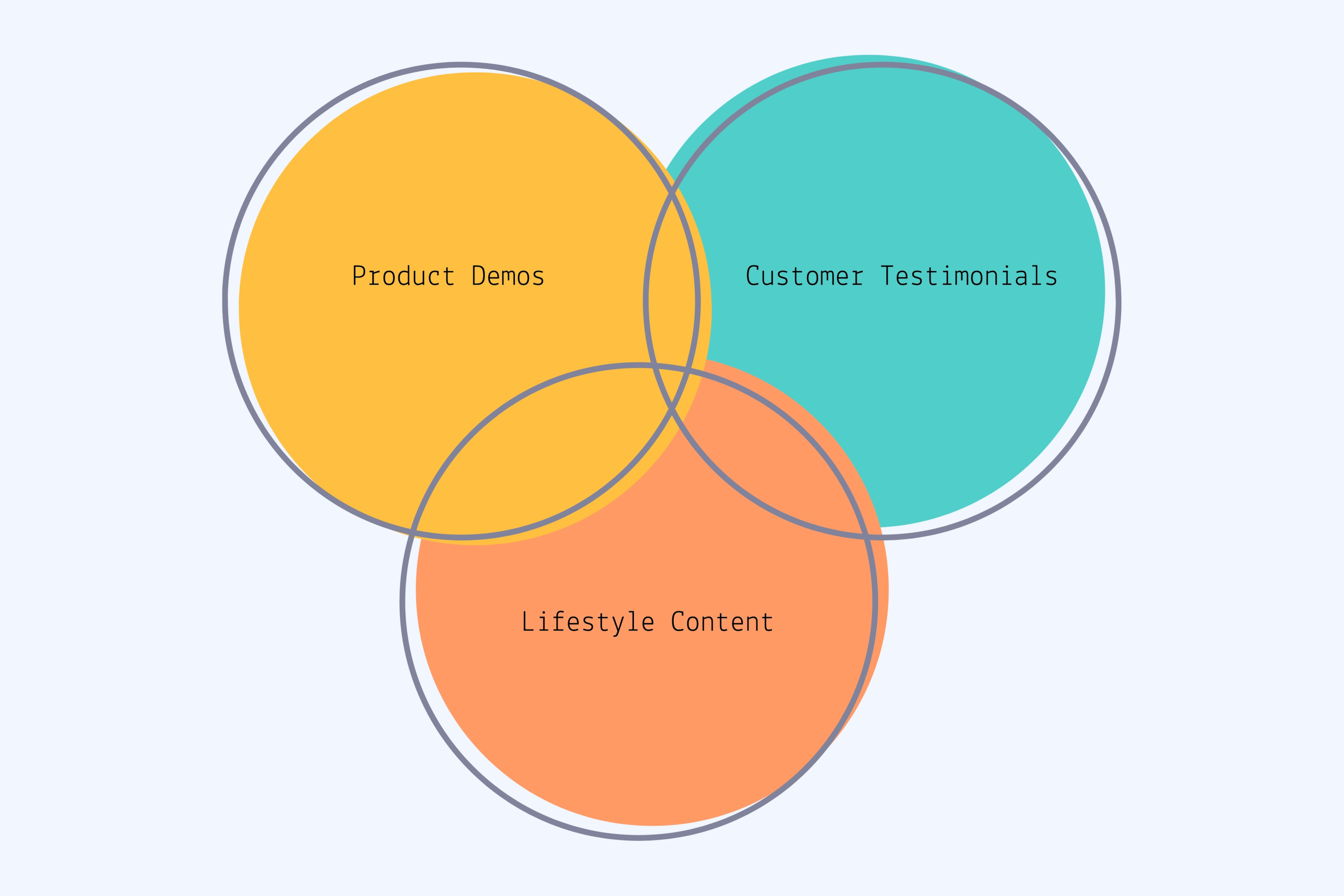
- Product demos that highlight key features
- Customer testimonials without unpredictability
- Lifestyle content that fits any scenario
Lu of Magalu worked with 40 brands in 12 months. She reached 39.9 million users. The estimated value hit €918k. These numbers prove virtual influencers drive real business results when brands execute quality campaigns at scale.
How Brands and Agencies Can Find Success with Virtual Influencers
Success with virtual influencers starts with clear strategy. You need goals, audience understanding, and realistic execution plans before you create any content.
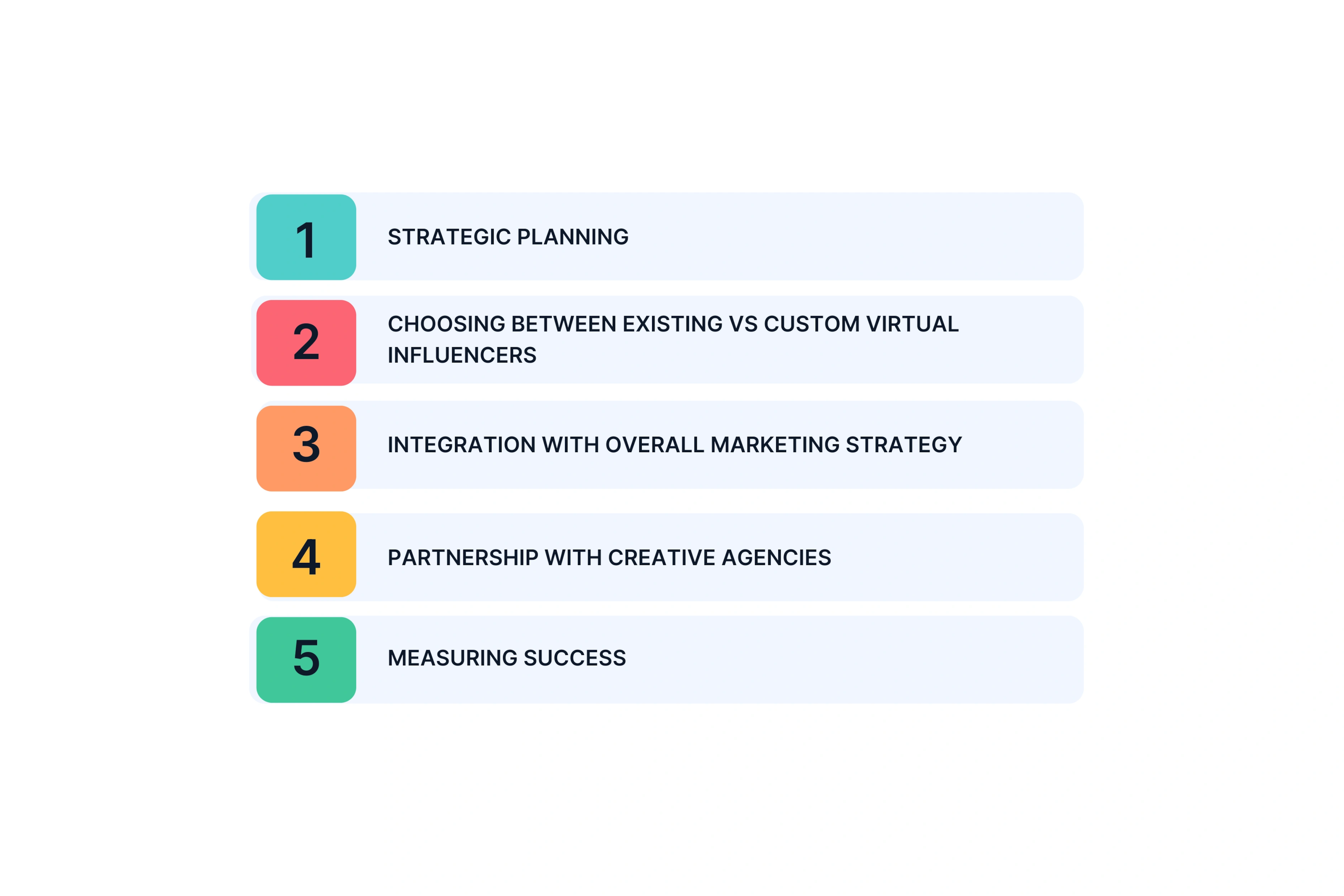
Strategic Planning
Define what you want to achieve before you start. Brand awareness? Product launches? Ongoing content? Your goals shape everything else. Virtual influencers work best when you align them with your brand values from day one.
Planning steps include:
- Set clear campaign objectives with measurable targets
- Understand your audience and their comfort with AI content
- Map brand values to your virtual character design
Skip this planning and you waste money on content that misses the mark. Your virtual influencer needs purpose beyond "we should try this."
Choosing Between Existing vs Custom Virtual Influencers
You have two paths. Partner with established virtual influencers like Lil Miquela. Or create custom characters designed for your brand. Established characters bring existing audiences. Custom ones give you complete ownership and perfect brand fit.
Existing virtual influencers offer:
- Built-in followers who already engage
- Proven track record of audience engagement
- Faster launch without creation time
Custom virtual influencers deliver:
- Perfect alignment with your target demographic
- Full ownership of the character and content
- Better long-term economics as you reuse assets
Most brands creating ongoing content programs choose custom. One-off campaigns often work with existing characters.
Integration with Overall Marketing Strategy
Virtual influencers should complement your other channels. They work alongside human influencers, not replace them. Use virtual characters for consistent brand messaging. Use human creators for authentic testimonials and emotional connection.
Smart integration means:
- Combining virtual and human content in campaigns
- Deploying across platforms with coordinated timing
- Measuring performance against same standards as other channels
Treat virtual influencers like any marketing channel. Track ROI. Optimize based on data. Cut what does not work.
Partnership with Creative Agencies
Quality execution separates success from failure. Most brands lack in-house expertise to create lifelike virtual influencers and produce professional content at scale. Creative partners who handle end-to-end production deliver better results faster.
Look for partners who provide:
- Custom virtual influencer design based on your audience
- Complete video production from script to final edit
- Strategic guidance on content strategy and platform optimization
Production timelines should be days not weeks. Quality should match or exceed your other content. Cost should make sense for your volume needs.
Measuring Success
Set KPIs before you launch. Track them like any other marketing investment. Go beyond follower counts and likes.
Key metrics include:
- Engagement rates compared to your other content
- Conversion data from virtual influencer posts
- Brand sentiment changes in your target audience
- Cost per acquisition vs traditional influencer campaigns
Create multiple content versions for A/B testing. See what messages and formats perform best. Use those insights to improve future campaigns. Your creative partner should deliver test-ready variations. You run the tests and share what works. They produce more of it.
How You Can Use Virtual Influencers for Your Brand
Most brands face a choice between generic virtual influencers or expensive in-house builds. Neither works well. Generic AI influencers do not fit your brand. Building in-house takes months and costs too much.
The Challenge with Generic Approaches
You can partner with existing virtual characters. They have followers already. But they work with dozens of other brands. Your message competes for attention. Their personality might not match your brand values. Marketing agencies report poor fit as the top complaint with established virtual influencers.
Generic problems include:
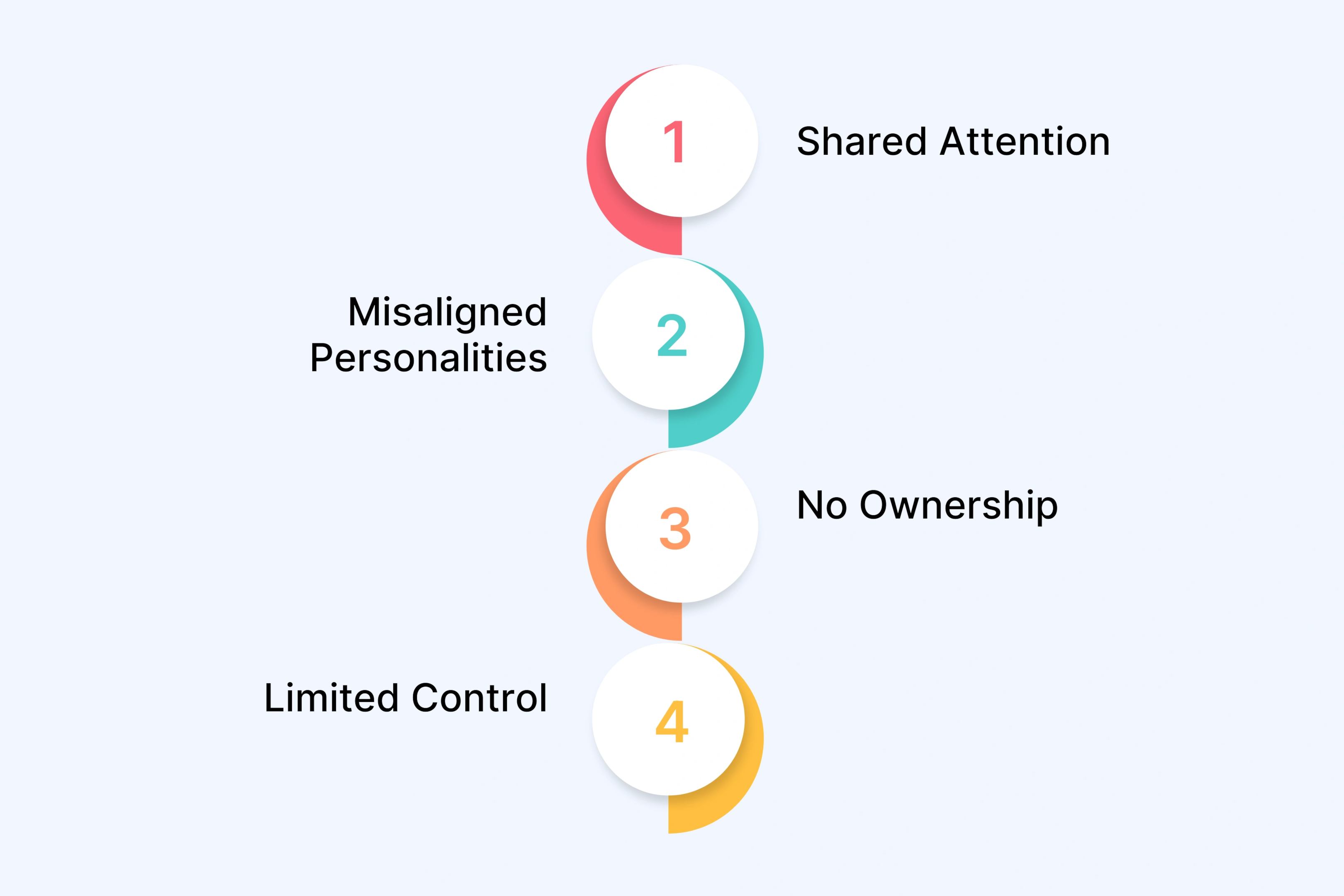
- Shared attention with competitor brands
- Misaligned personalities that feel forced
- No ownership of the character or content
- Limited control over posting and messaging
Unlike working with a real person where authenticity matters, virtual influencers should fit your brand perfectly. Generic ones rarely do.
The Custom Approach That Works
Create virtual influencers designed around your ideal customer profile. Match their ethnicity, gender, age, and style to who you want to reach. Build their personality to reflect your brand values. This precision delivers better results than hoping a generic character resonates.
Custom benefits include:

- Perfect demographic match to your target audience
- Complete ownership for unlimited reuse
- Full control over every detail and message
- Better economics as you scale content production
Fashion brands create virtual models for their aesthetic. Tech companies design characters that embody innovation. Even niche categories like virtual rappers work when personality matches audience expectations.
Practical Applications by Industry
Different businesses use virtual influencers different ways. Your application depends on your goals and audience.
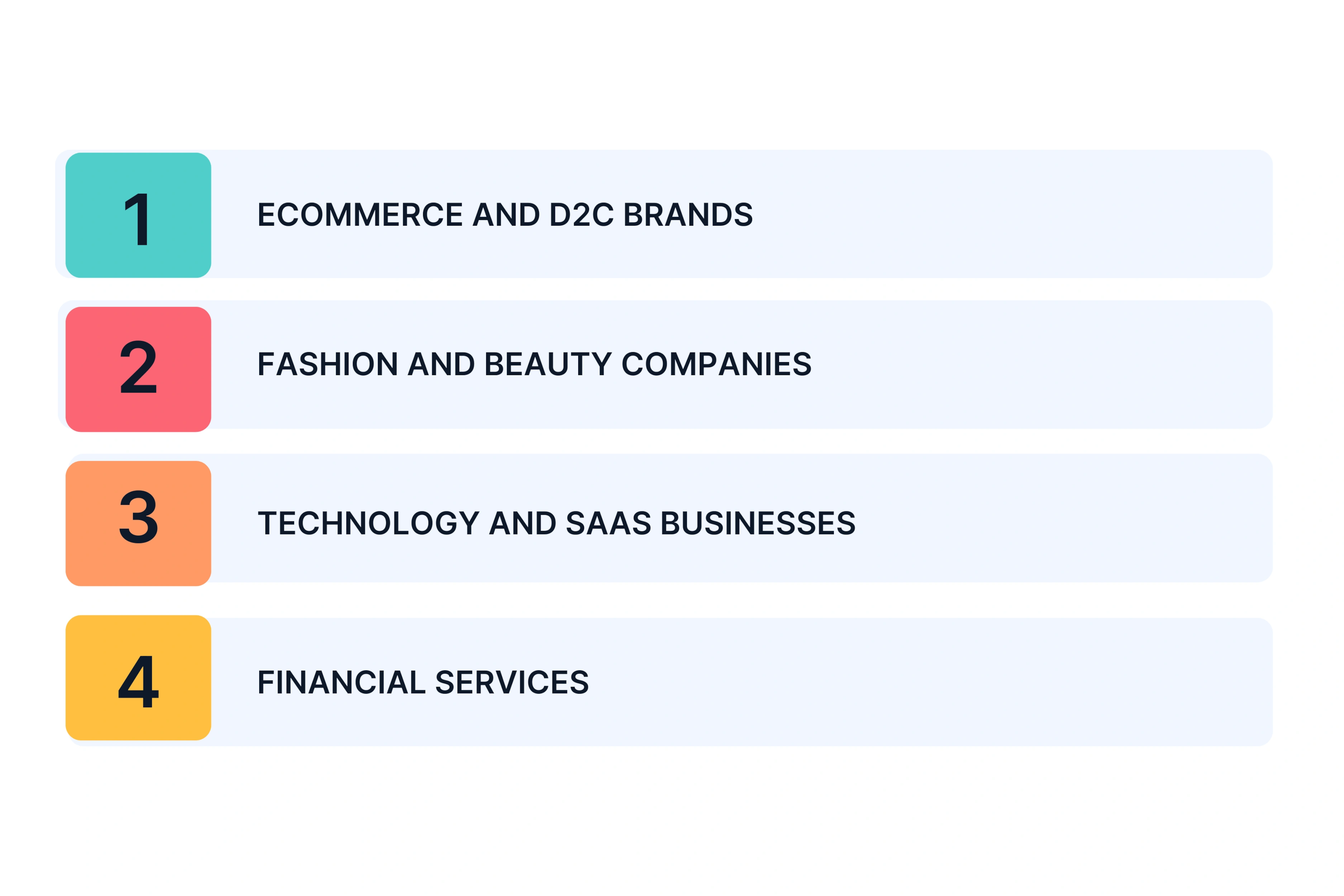
- Ecommerce and D2C brands create UGC, product demos, and customer testimonials. The virtual format lets you showcase products perfectly every time.
- Fashion and beauty companies use virtual models for product photography, seasonal campaigns, and social content across multiple platforms. One character works on Instagram, TikTok, YouTube, and your website.
- Technology and SaaS businesses deploy virtual advocates to explain complex products, create educational content, and demonstrate use cases that would be hard to film with real people.
- Financial services use virtual advisors for educational content, personalized video messages, and compliance-friendly messaging with complete control.
Working with Creative Partners
Quality execution matters more than speed. Look for creative partners who design custom virtual influencers, produce complete videos from script to final edit, and deliver content ready to post. Production should take days not weeks. Quality should match your other brand content. The right partner handles complexity so you focus on strategy and results.
How Virtual Influencers Can Impact Brands If Not Used Right
Virtual influencer marketing carries real risks when you skip strategy or cut corners on execution. Poor implementation damages your brand faster than it builds awareness.
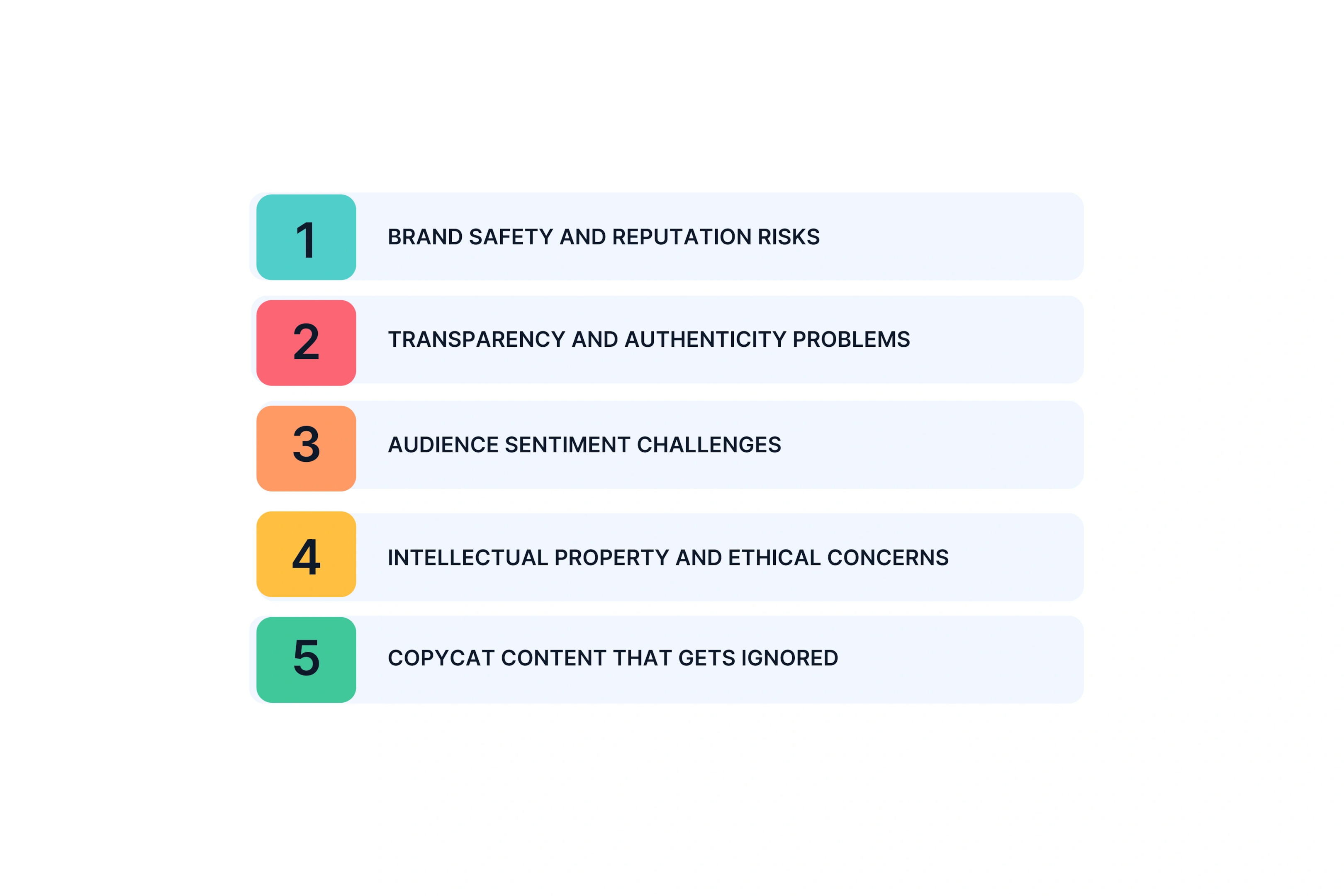
Brand Safety and Reputation Risks
Push virtual content on the wrong audience and you face backlash. Your brand looks tone deaf or desperate to follow trends.
Reputation risks include:
- Audience rejection when execution feels cheap or creepy
- Social media criticism that goes viral for wrong reasons
- Lost trust from customers who value authenticity
Marketing agencies report that failed virtual influencer launches stick to brands. One bad campaign becomes a cautionary tale that competitors reference.
Transparency and Authenticity Problems
FTC guidelines require virtual influencers to disclose brand sponsorships just like human influencers. But transparency goes deeper. Most of the consumers cannot tell AI content from human-created content. Trying to fool audiences always backfires.
Be clear about:
- What your digital personalities actually are
- When content uses AI generation
- How virtual characters relate to your brand
Audiences forgive AI use when you are honest. They punish deception hard. Brands connect better with transparency than tricks.
Audience Sentiment Challenges
96% of brands with no virtual influencer plans cite consumer trust as the reason. This hesitation reflects real market resistance. Not every audience wants virtual content. Older demographics especially prefer real people.
Sentiment problems include:
- Mixed reactions to virtual vs human content
- Generational gaps in acceptance rates
- Industry-specific resistance in traditional sectors
Test before you commit. Run small campaigns. Measure sentiment carefully. If your audience rejects the approach, pivot fast.
Intellectual Property and Ethical Concerns
AI creators have been accused of stealing content from human creators without credit. Brands using virtual influencers must ensure their creation does not infringe on others' work.
Protect yourself by:
- Verifying AI training data comes from ethical sources
- Ensuring virtual characters do not copy real people
- Securing proper licensing for any incorporated assets
Beyond legal requirements, ethical use matters. AI avatars or virtual influencers should complement human creators, not replace them with cheaper alternatives.
Copycat Content That Gets Ignored
Generic virtual influencers using similar looks and boring content get scrolled past. As adoption increases, audiences become desensitized to virtual characters that all feel identical.
Differentiation failures include:
- Cookie-cutter aesthetics that blend into noise
- Predictable content without unique personality
- Low production quality that screams cheap execution
Your digital personality needs unique traits, consistent storytelling, and quality production. Stand out with distinctive characters and compelling narratives. Cheap execution wastes money without delivering results.
The Future: What's Next for Virtual Influencers
The virtual influencer market will grow from $6 billion in 2024 to $45 billion by 2030. Technology keeps improving. Virtual personas will become harder to distinguish from real people in appearance and behavior.
Several trends will reshape influencer marketing:

- Platform expansion means AI influencers move beyond Instagram and TikTok into metaverse environments and virtual reality spaces where their digital nature fits perfectly.
- Increased personalization lets virtual characters adapt messaging and appearance for different audience segments automatically. One character creates millions of targeted variations.
- Hybrid strategies combining virtual and human influencers become standard. Brands use virtual influencer marketing for consistency and scale. Human creators add authentic connection.
- Regulatory changes will bring stricter disclosure requirements and guidelines around deceptive practices.
- Quality differentiation separates winners from followers. Only compelling, well-executed virtual personas break through crowded feeds. Early movers who build expertise now will lead. Latecomers will struggle to catch up in competitive markets.
FAQs
Can virtual influencers go viral?
Yes. Lil Miquela's Calvin Klein campaign with Bella Hadid sparked massive conversation and reached millions beyond her follower base. Virtual avatars go viral when they offer exceptional creative execution, controversial or unexpected content, or participation in cultural moments. The novelty factor drives organic sharing as audiences discover these AI generated content creators.
Can virtual influencers replace human influencers in all types of campaigns?
No. Virtual influencers work best for consistent brand messaging and scalable content. Human influencers excel at authentic testimonials, emotional storytelling, and building deep relationships through human interaction. The authentic connection between real creators and audiences cannot be replicated by artificial intelligence. Use virtual for control and consistency. Use human for genuine emotion and unpredictability.
How do virtual influencers compare to AI chatbots or AI assistants?
Virtual influencers create content and build audiences on social platforms. AI chatbots handle customer service and answer questions. Virtual influencers broadcast to many people through influencer marketing campaigns. Chatbots have one-to-one conversations for support. The technology overlaps but the purpose differs completely.
Can virtual influencers collaborate with human influencers?
Yes. Hybrid campaigns pairing virtual and human creators generate strong results. Lil Miquela worked with Bella Hadid. These collaborations create buzz by highlighting the contrast between virtual and real while showing they can coexist in campaigns.
What are the benefits of virtual influencers?
You get complete creative control, no scandals or PR risks, 24/7 availability across platforms, cost effectiveness over time, high novelty value, consistency in messaging, and ability to target specific demographics precisely. Virtual avatars maintain perfect brand alignment while scaling content production efficiently.
Why do brands work with virtual influencers?
Brands want total control over content, zero scandal risk, no PR disasters, constant availability, cost savings on long-term campaigns, and novelty that captures attention. AI influencers deliver predictable results that human creators cannot guarantee.
Conclusion
Virtual influencers are changing influencer marketing across social media platforms. They give you control, consistency, and scale that human counterparts cannot match. But success requires strategy, quality execution, and understanding your audience.
AI influencers work best when they complement human creators, not replace them. Poor execution damages brands. Quality production drives results. The artificial intelligence behind these digital characters keeps improving.
Early movers gain advantages while others wait. Your next step is clear. Schedule your strategy call now to explore how custom virtual influencers fit your social media goals and brand vision.



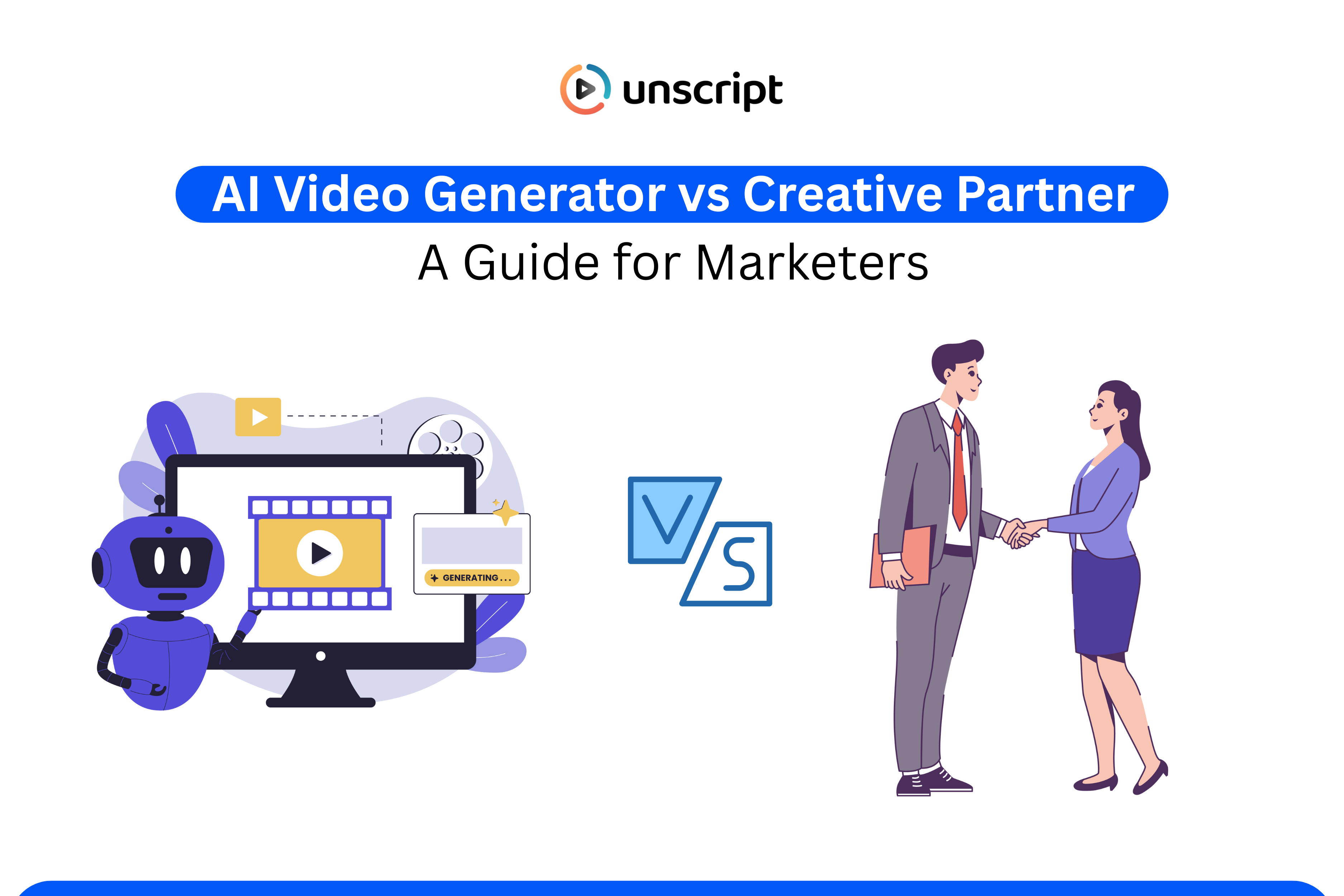
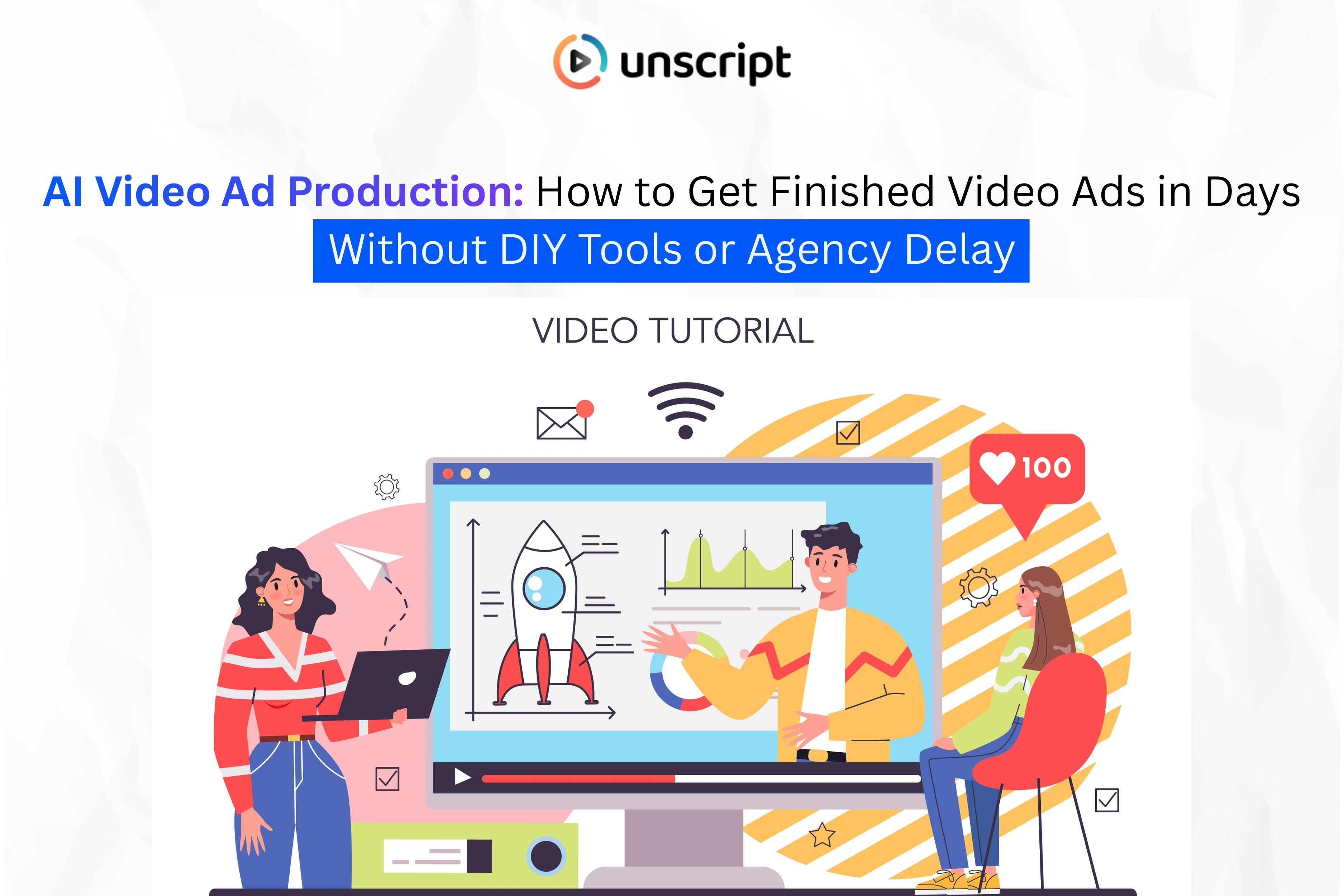










.png)





















.svg)
.svg)
%201.svg)







.svg)
